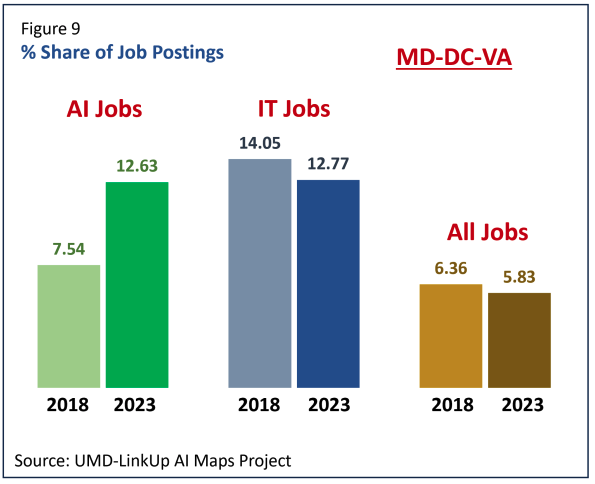
The University of Maryland’s Robert H. Smith School of Business is leading the charge to understand how artificial intelligence is impacting jobs in the U.S. economy with the world’s first attempt to map the creation of AI-skilled jobs. The Smith School just launched UMD-LinkUp AI Maps, a dynamic tool that uses job posting data to analyze the spread of jobs requiring AI skills across the country – by sector, state and more granular geographic levels.
The interactive website (and the maps embedded in it) allows users to track U.S.-based job postings that require AI skills. The data is updated each month. The tool ranks states and regions by their share of AI jobs and allows users to do a deeper dive across economic sectors, metropolitan areas, and counties. It also determines a region’s AI intensity: the ratio of its AI jobs to all other job postings.
Anil K. Gupta, the Michael Dingman Chair and professor of Strategy, Globalization and Entrepreneurship, leads the project for the Smith School. Jon Norberg, Chief Strategy Officer at job market data firm LinkUp, co-leads the project with Gupta. Other members of the project team include Evan Schnidman, CEO of consulting firm Outrigger Group, and Smith professors Siva Viswanathan and Kunpeng Zhang, as well as PhD student Hanwen Shi.
 An analysis of initial findings from the UMD-LinkUp AI Maps shows AI jobs are on the upswing, despite a decline in IT jobs in general. The findings, detailed in a January 2024 white paper titled “From West to the Rest,” show the dispersion of AI jobs outside of California, which still commands the biggest share. It pinpoints regions that have seen the highest growth in the number of AI jobs, including the Washington, D.C. region. The National Capital Region has emerged as the second biggest hub for AI jobs, thanks to the concentration of federal agencies and defense and aerospace contractors that have embraced the new technologies. When you compare the number of AI jobs to all job postings in a region, Washington, D.C. ranks No. 1, Virginia ranks No. 2, and Maryland comes in at No. 7.
An analysis of initial findings from the UMD-LinkUp AI Maps shows AI jobs are on the upswing, despite a decline in IT jobs in general. The findings, detailed in a January 2024 white paper titled “From West to the Rest,” show the dispersion of AI jobs outside of California, which still commands the biggest share. It pinpoints regions that have seen the highest growth in the number of AI jobs, including the Washington, D.C. region. The National Capital Region has emerged as the second biggest hub for AI jobs, thanks to the concentration of federal agencies and defense and aerospace contractors that have embraced the new technologies. When you compare the number of AI jobs to all job postings in a region, Washington, D.C. ranks No. 1, Virginia ranks No. 2, and Maryland comes in at No. 7.
Understanding how jobs that require AI skills are dispersing throughout the country is an important indicator for how different regions stack up against each other and the overall health of the U.S. economy, says Gupta. Over time, the data tool will also help users understand what skills employers throughout the country are looking for as AI becomes integral to more firms.
“This will define how to visualize and understand the landscape of AI job creation as it continues to evolve,” Gupta says. “We have been able to combine academic rigor, highly accurate employment data, and expertise in AI methodologies to help figure out how the demand for AI skills is evolving throughout the U.S.”.
Gupta says this new approach is much more accurate than past attempts to figure out the AI jobs picture. Previous methods have been extremely flawed – with up to 70% false positives – because they have relied on keywords instead of the more recently developed AI inference technologies, he says. The Smith School’s tool uses a fine-tuned large language model (LLM), powered by cutting-edge AI technologies, to differentiate jobs the way a human would when reading job descriptions. When multiple AI researchers checked the tool, they found it has an over 90% accuracy rate.
“In short, we are using AI to track the dispersion of AI jobs,” Gupta says. “We are using highly specialized LLMs to assist with filtering AI jobs for an accurate and timely assessment of what constitutes an AI job.”
This is just the latest example of how the Smith School is taking on grand challenges and exploring the impact of AI in business.
“MD-LinkUp AI Maps exemplifies the type of industry- and policy-relevant research being done at the Smith School on the rapidly growing impact of AI on the U.S. economy,” says Prabhudev Konana, dean of Smith School. “Our faculty are studying how artificial intelligence is changing the world and we’re using that to develop leaders who understand how to use the transformational technology to benefit society for the future.”
In addition to AI’s impact on jobs and the economy, Smith’s world-leading faculty are studying how AI can revolutionize health care, government agencies, customer service, product innovation and problem-solving. Faculty are bringing their research into the classroom, as the Smith School incorporates the exploration of AI and mastery of related skills into the curriculum at all levels.
Media Contact
Greg Muraski
Media Relations Manager
301-405-5283
301-892-0973 Mobile
gmuraski@umd.edu
Get Smith Brain Trust Delivered To Your Inbox Every Week
Business moves fast in the 21st century. Stay one step ahead with bite-sized business insights from the Smith School's world-class faculty.